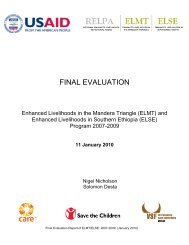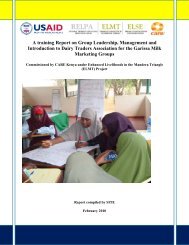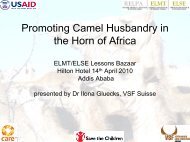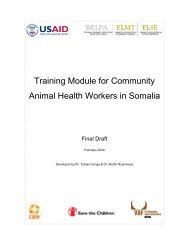Impact Assessment of the Community Animal Health System in ...
Impact Assessment of the Community Animal Health System in ...
Impact Assessment of the Community Animal Health System in ...
Create successful ePaper yourself
Turn your PDF publications into a flip-book with our unique Google optimized e-Paper software.
herds <strong>the</strong>se changes were not statistically significant, but were cl<strong>in</strong>ically significant. For PPR<br />
(supportive treatment), CFRs were higher <strong>in</strong> CAHW‐treated herds.<br />
Table 3. Comparison <strong>of</strong> case fatality rates <strong>in</strong> sheep and goats follow<strong>in</strong>g CAHW and owner treatments<br />
Disease<br />
CCPP<br />
CAHW treatments<br />
Median case<br />
fatality rate (%)<br />
28.5<br />
(n=84 flocks)<br />
Type <strong>of</strong> medic<strong>in</strong>e<br />
and strategy a<br />
Oxytetracycl<strong>in</strong>e,<br />
curative<br />
Owner treatments<br />
Median case<br />
fatality rate (%)<br />
63.4<br />
(n=36 flocks)<br />
Type <strong>of</strong> medic<strong>in</strong>e<br />
Tetracycl<strong>in</strong>e capsule<br />
Median difference<br />
<strong>in</strong> case fatality rates<br />
(%)(95% CI)<br />
31.6 (20.5, 41.7)*<br />
Mange<br />
4.9<br />
(n=36 flocks)<br />
Ivermect<strong>in</strong>,<br />
curative<br />
40.0<br />
(n=11 flocks)<br />
Diaz<strong>in</strong>on spray<br />
33.3 (15.4, 47.6)*<br />
Tick borne<br />
disease b<br />
37.9<br />
(n=16 flocks)<br />
Oxytetracycl<strong>in</strong>e,<br />
curative<br />
58.3<br />
(n=6 flocks)<br />
Oxytetracycl<strong>in</strong>e<br />
10.6 (‐27.5, 53.3)<br />
NSD<br />
48.3<br />
(n=36 flocks)<br />
Oxytetracycl<strong>in</strong>e,<br />
supportive<br />
91.7<br />
(n=14 flocks)<br />
Oxytetracycl<strong>in</strong>e<br />
33.9 (16.0, 54.6)*<br />
Helm<strong>in</strong>thosis<br />
10.5<br />
(n=29 flocks)<br />
Albendazole,<br />
curative<br />
50.0<br />
(n=11 flocks)<br />
Albendazole or<br />
tetramisole<br />
21.4 (12.5, 50.0)*<br />
PPR<br />
59.2<br />
(n=50 flocks)<br />
Tylos<strong>in</strong>,<br />
supportive<br />
42.9<br />
(n=11 flocks)<br />
Dihydrostreptomyc<strong>in</strong><br />
tablets<br />
4.6 (‐14.3, 26.7)<br />
Sheep and<br />
goat pox<br />
23.9<br />
(n=28 flocks)<br />
Oxytetracycl<strong>in</strong>e,<br />
supportive<br />
34.9<br />
(n=19 flocks)<br />
Not treated<br />
11.1 (‐25.9, 2.6)<br />
O<strong>the</strong>r c<br />
19.3<br />
(n=32 flocks)<br />
Various,<br />
supportive and<br />
curative<br />
33.3<br />
(n=15 flocks)<br />
Various<br />
2.9 (‐31.9, 11.1)<br />
Notes<br />
* Significant at <strong>the</strong> 95% confidence level, us<strong>in</strong>g confidence <strong>in</strong>terval analysis.<br />
a Supportive treatments used <strong>in</strong> viral <strong>in</strong>fection and <strong>in</strong>volved <strong>the</strong> use <strong>of</strong> antibiotic to treat secondary bacterial <strong>in</strong>fections.<br />
b Assumed to be babesiosis or anaplasmosis.<br />
c O<strong>the</strong>r diseases were footrot, lice <strong>in</strong>festation, botulism, bloat, ‘swollen head’ and non‐specific abortion.<br />
CCPP – contagious capr<strong>in</strong>e pleuropneumonia; NSD – Nairobi sheep disease; PPR – peste des petits rum<strong>in</strong>ants<br />
Case fatality rates <strong>in</strong> camels<br />
CAHWs provided curative treatments for five diseases or disease‐forms viz. acute trypanosomosis,<br />
chronic trypansomosis, respiratory disease (cough<strong>in</strong>g), mange and helm<strong>in</strong>thosis, and supportive<br />
treatments for one disease viz. camel pox (Table 4). For three out <strong>of</strong> five diseases where curative<br />
treatments were used by CAHWs, CFRs were significantly lower <strong>in</strong> CAHW‐treated cases relative to<br />
cases treated by livestock keepers. These median reductions <strong>in</strong> CFR were substantial: 25.0% for<br />
respiratory disease; 42.9% for mange; and 43.2% for helm<strong>in</strong>thosis. For trypanosomosis (acute and<br />
chronic), camel pox, paralysis and ‘o<strong>the</strong>r’ diseases, CFRs were lower <strong>in</strong> CAHW‐treated herds.<br />
Compared with CFRs <strong>in</strong> owner‐treated herds <strong>the</strong>se changes were not statistically significant, but were<br />
cl<strong>in</strong>ically significant.<br />
Case fatality rates <strong>in</strong> cattle<br />
CAHWs provided curative treatments for three diseases viz. trypanosomosis, contagious bov<strong>in</strong>e<br />
pleuropnuemonia (CBPP) and helm<strong>in</strong>thosis. For all three diseases <strong>the</strong>re was a significantly lower CFR<br />
<strong>in</strong> CAHW‐treated herds relative to owner‐treated herds (Table 5). For ‘o<strong>the</strong>r’ diseases <strong>the</strong>re was a<br />
lower CFR <strong>in</strong> CAHW‐treated herds which was cl<strong>in</strong>ically, but not statistically, significant.<br />
9












